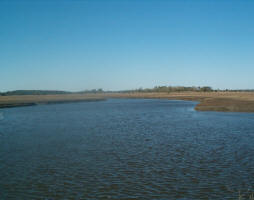 Study Reveals Large, Untapped Potential for Water and Sanitation Services for the World's Poor
Study Reveals Large, Untapped Potential for Water and Sanitation Services for the World's Poor
Many of the poorest, un-served people in developing countries, for whom public water and sanitation services are out of reach, could increasingly rely on service provision through the domestic private sector. Tapping the Markets: Opportunities for Domestic Investments in Water and Sanitation for the Poor, a new report today released by the World Bank’s Water and Sanitation Program (WSP) and the International Finance Corporation (IFC), finds that this will not only improve their livelihoods but is also an enormous market potential which waits to be tapped.
Today, 2.5 billion people lack access to sanitation and at least 780 million people lack access to safe drinking water. Global estimates of economic losses from the lack of access to water and sanitation are estimated at US$260 billion every year. “The public sector alone cannot meet this massive challenge; if we want to end extreme poverty by 2030 and boost shared prosperity for the bottom 40%, we will have to scale up water and sanitation access,” said WSP Manager Jae So. “And to do that, both the public and private sector will need to work together.”
One of the most striking findings of the report is the enormous market potential. Focusing only on Bangladesh, Benin, and Cambodia, about 20 million people are projected to obtain their water from rural piped water schemes by 2025. That is 10 times the current number, a market worth at least US$90 million a year. On the sanitation side, there is a potential US$700 million Bottom of the Pyramid market in Bangladesh, Indonesia, Peru, and Tanzania. The current total market for improved on-site sanitation services in these four countries is estimated to be worth US$2.6 billion.
Read the
blog Five Myths about the Business of Sanitation.
Read the Feature
Story on the World Bank homepage.
Read the press
release.
Download the Conference Editions of the two studies:
- Tapping the Market: Opportunities for Domestic Investments in Water for the Poor
- Tapping the Market: Opportunities for Domestic Investments in Sanitation for the Poor
Thirsty Energy: Will Water Constrain Our Energy Future?
In order to support our client countries’ efforts to
address the challenges in energy and water resources development, the World Bank
has embarked on a global initiative, Thirsty Energy, which will help governments
break disciplinary silos that prevent cross-sectoral planning to avoid future
unsustainable scenarios. The objective of this initiative is to quantify and
evaluate the tradeoffs and synergies between water and energy planning and to
identify potential constraints resulting from their interdependency.
Thirsty Energy, the first publication of the initiative, introduces
the energy-water nexus, examines the water requirements of power generation and
outlines some potential technical and institutional solutions for improving the
management of the nexus.
Read the
blog Thirsty Energy: Making the Energy-Water Nexus Work For
Us.
Discover the energy-water challenge infographic.
Learn more
about the water-energy nexus and the Thirsty Energy Initiative.
Economics of Sanitation Initiative
The Economics of Sanitation Initiative was launched in 2007
with a WSP study from East Asia, which found that the economic costs of poor
sanitation and hygiene amounted to over US$9.2 billion a year (2005 prices) in
Cambodia, Indonesia, Lao PDR, the Philippines, and Vietnam. The groundbreaking
study was the first of its kind to attribute dollar amounts to a country’s
losses from poor sanitation.
The ESI initiative was born as a response
by WSP to address major gaps in evidence among developing countries on the
economic impacts of sanitation. Following the success in East Asia, ESI studies
were completed in Africa and South Asia, with a study currently underway in
Latin America.
Discover
the What's a Toilet Worth?
infographic.
Read Guy
Hutton's blog What's a Toilet Worth?
Read more about
the Economics of Sanitation Initiative.
Don't forget to visit us at our booth or one of the remaining sessions:
World Bank/WSP Booth
- Booth B02:20
Our Sessions for the rest of the week:
- Partnerships for Financing Sanitation Services in Poor Urban Communities (9/4, 9:00-12:30pm, K22/23)
- Changing Relationships: ICT to Improve Water Governance (Watch Live Stream Video) (9/4, 9:00-12:30pm, B7)
- Aid Effectiveness in WASH Relief to Development Transition (9/5, 9:00-12:30pm, B8)
- Transboundary Governance for Resilience and Development (9/5, 1:00-4:15pm, K21)
- Water Scarcity and Risk Mapping Using Geo and Satellite Data (9/5, 2:00-5:30pm, K2)
For session details and overview, click here.
| Contact information |
Shahina Zahir, World Bank
(email: fzahir1@worldbank.org ; worldbankwater@worldbank.org) |
|---|---|
| News type | Inbrief |
| File link |
http://www.wsp.org/FeaturesEvents/Calendar/world-water-week-2012 |
| Source of information | World Bank |
| Subject(s) | ANALYSIS AND TESTS , CHARACTERISTICAL PARAMETERS OF WATERS AND SLUDGES , DRINKING WATER , DRINKING WATER AND SANITATION : COMMON PROCESSES OF PURIFICATION AND TREATMENT , ENERGY , FINANCE-ECONOMY , HEALTH - HYGIENE - PATHOGENIC MICROORGANISM , HYDRAULICS - HYDROLOGY , INDUSTRY , INFRASTRUCTURES , PREVENTION AND NUISANCES POLLUTION , RISKS AND CLIMATOLOGY , SANITATION -STRICT PURIFICATION PROCESSES , SLUDGES , WATER QUALITY |
| Relation | http://vx.worldbank.org/t/3692730/24850937/65269/0/ |
| Geographical coverage | n/a |
| News date | 04/09/2013 |
| Working language(s) | ENGLISH |
 you are not logged in
you are not logged in





